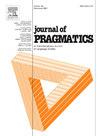“Uh, I'm a pretty sick guy”: The dialogue of American Psycho in fiction and film
IF 1.7
1区 文学
0 LANGUAGE & LINGUISTICS
引用次数: 0
Abstract
This paper examines how dialogue in Bret Easton Ellis's novel American Psycho (1991) serves to project the identity of its controversial protagonist Patrick Bateman. A comparison with the dialogue in Mary Harron's film adaptation (2000) further highlights the importance of dialogue for characterisation by analysing how changes in Bateman's conversational behaviour on screen result in a different interpretation of the character. A pragmastylistic analysis reveals that dialogues are characterised by a strong discrepancy between their form and their content. While Conversation Analysis exposes few irregularities in the turn-taking structure of the dialogues, a Gricean pragmatic analysis confirms the impression that the content of the dialogues is often vapid – the participants fail to establish a meaningful connection with one another through a cooperative exchange of information. Bateman tries to disrupt the vapid interaction by confessing ever more openly to his killing sprees in a desperate attempt to establish some genuine contact. However, as the dialogues maintain the semblance of conversation, his shocking confessions go completely unnoticed. A scene-based analysis of the film, complete with a multimodal transcript, provides an insight into how the reduction of Bateman's deviances significantly alters his characterisation.
“呃,我是一个相当恶心的家伙”:小说和电影中的美国精神病对话
本文考察了布雷特·伊斯顿·埃利斯的小说《美国精神病患者》(1991)中的对话是如何塑造其备受争议的主人公帕特里克·贝特曼的身份的。通过与玛丽·哈伦(Mary Harron) 2000年改编的电影中的对话进行比较,分析贝特曼在银幕上的对话行为变化如何导致对角色的不同解读,进一步强调了对话对人物塑造的重要性。语用文体学分析表明,对话的特点是形式与内容之间存在着强烈的差异。虽然《对话分析》揭示了对话的轮流结构中很少有不规则之处,但格里安语用分析证实了对话的内容通常是乏味的——参与者无法通过合作的信息交换与彼此建立有意义的联系。贝特曼试图打破这种乏味的互动,他更公开地承认自己的杀戮狂潮,绝望地试图建立一些真正的联系。然而,由于对话保持着对话的表象,他令人震惊的忏悔完全没有被注意到。基于场景的电影分析,完成了多模态文字记录,提供了一个洞察贝特曼的偏差的减少如何显着改变了他的性格。
本文章由计算机程序翻译,如有差异,请以英文原文为准。
求助全文
约1分钟内获得全文
求助全文
来源期刊

Journal of Pragmatics
Multiple-
CiteScore
3.90
自引率
18.80%
发文量
219
期刊介绍:
Since 1977, the Journal of Pragmatics has provided a forum for bringing together a wide range of research in pragmatics, including cognitive pragmatics, corpus pragmatics, experimental pragmatics, historical pragmatics, interpersonal pragmatics, multimodal pragmatics, sociopragmatics, theoretical pragmatics and related fields. Our aim is to publish innovative pragmatic scholarship from all perspectives, which contributes to theories of how speakers produce and interpret language in different contexts drawing on attested data from a wide range of languages/cultures in different parts of the world. The Journal of Pragmatics also encourages work that uses attested language data to explore the relationship between pragmatics and neighbouring research areas such as semantics, discourse analysis, conversation analysis and ethnomethodology, interactional linguistics, sociolinguistics, linguistic anthropology, media studies, psychology, sociology, and the philosophy of language. Alongside full-length articles, discussion notes and book reviews, the journal welcomes proposals for high quality special issues in all areas of pragmatics which make a significant contribution to a topical or developing area at the cutting-edge of research.
 求助内容:
求助内容: 应助结果提醒方式:
应助结果提醒方式:


